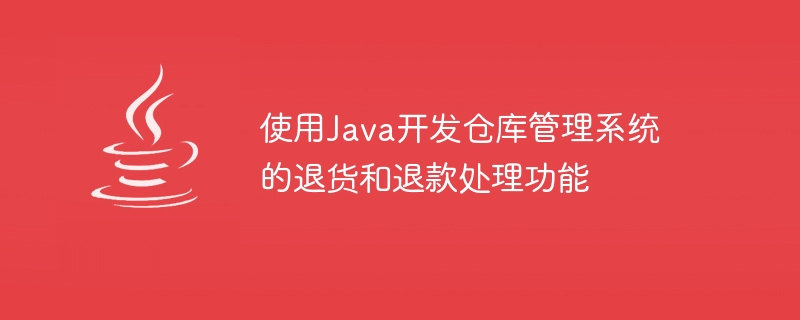

Java develops return and refund processing functions of warehouse management systems
With the rapid development of e-commerce, warehouse management systems play an important role in the e-commerce industry Role. The warehouse management system not only needs to manage the incoming and outgoing of goods, but also needs to handle returns and refunds. This article will introduce how to use Java to develop the return and refund processing functions of a warehouse management system and provide specific code examples.
1. Requirements analysis
Before development, needs analysis must first be conducted. The main requirements for the return and refund processing function are as follows:
2. System design
After completing the requirements analysis, system design needs to be carried out. Corresponding database tables and Java classes can be designed according to specific needs. The following is a simple system design example:
3. Code Implementation
The following is a simple Java code example that implements the return and refund processing function:
public class ReturnApplication {
private int id;
private int customerId;
private int productId;
private String reason;
private int quantity;
// 省略构造方法和getter/setter方法
}
public class RefundOrder {
private String orderNumber;
private double amount;
private String paymentMethod;
// 省略构造方法和getter/setter方法
}
public class WarehouseManagementSystem {
public void processReturnApplication(ReturnApplication returnApplication) {
// 根据退货申请处理退货逻辑
// 更新退货库存信息等
}
public void generateRefundOrder(ReturnApplication returnApplication) {
// 根据退货申请生成退款单
RefundOrder refundOrder = new RefundOrder();
refundOrder.setOrderNumber(UUID.randomUUID().toString());
refundOrder.setAmount(returnApplication.getQuantity() * getProductPrice(returnApplication.getProductId()));
refundOrder.setPaymentMethod("支付宝");
// 将退款单信息保存到数据库
saveRefundOrder(refundOrder);
}
private double getProductPrice(int productId) {
// 根据商品ID查询商品价格
// 这里省略具体实现
return 0.0;
}
private void saveRefundOrder(RefundOrder refundOrder) {
// 将退款单信息保存到数据库
// 这里省略具体实现
}
}
public class Main {
public static void main(String[] args) {
ReturnApplication returnApplication = new ReturnApplication();
returnApplication.setId(1);
returnApplication.setCustomerId(1);
returnApplication.setProductId(1);
returnApplication.setReason("商品破损");
returnApplication.setQuantity(2);
WarehouseManagementSystem warehouseManagementSystem = new WarehouseManagementSystem();
warehouseManagementSystem.processReturnApplication(returnApplication);
warehouseManagementSystem.generateRefundOrder(returnApplication);
}
}The above code is a simplified version Examples, the specific implementation should be appropriately adjusted and improved according to actual needs.
4. Summary
This article introduces how to use Java to develop the return and refund processing functions of the warehouse management system, and provides specific code examples. Through this function, customers' return applications can be effectively processed and corresponding refund orders can be generated to improve the e-commerce warehouse management system. Of course, the specific implementation still needs to be appropriately adjusted and improved according to actual business needs.
The above is the detailed content of Using Java to develop return and refund processing functions of warehouse management systems. For more information, please follow other related articles on the PHP Chinese website!




